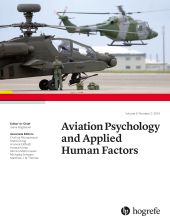Construct Validity of the Temperament Structure Scales Within the Big Five Framework in Aerospace Selection
Abstract
Abstract. The Temperament Structure Scales (TSS) are used in the selection of pilots, air traffic controllers, and astronauts at the German Aerospace Center (DLR). As there is evidence for the predictive validity of the TSS, its relationship with the popular Big Five factors as indicators of construct validity is investigated. Two samples comprising either European astronaut candidates (N = 902) or German pilot candidates (N = 249) were used. Analyses show consistent commonalities of several TSS scales with four Big Five factors (Neuroticism, Extraversion, Agreeableness, Conscientiousness). The TSS cover most of the broad Big Five factors and additionally provide a more detailed and suitable profile with unique constructs for the selection of aerospace personnel. The TSS are thus recommended for use without additional personality inventories that measure the broad Big Five factors only.
References
(2011). The NEO-PI-R as a premorbid baseline measure. Technical Report AFRL-SA-WP-TR-2011–0001. Brooks City-Base, TX: Air Force Research Laboratory.
(2010). Meta-analysis of personality assessments as predictors of military aviation training success. The International Journal of Aviation Psychology, 20, 92–109.
(2013).
Pilot selection methods . In B. H. KantowitzP. S. TsangM. A. VidulichEds., Human factors in transportation: Principles and practices of aviation psychology (pp. 357–396). Mahwah, NJ: Erlbaum.(2014). Consistency of the relations of cognitive ability and personality traits to pilot training performance. The International Journal of Aviation Psychology, 24, 247–264. doi: 10.1080/10508414.2014.949200
(1991). Pilot personality and crew coordination: Implication for training and selection. The International Journal of Aviation Psychology, 1, 25–44. doi: 10.1207/s15327108ijap0101_3
(1994). Exploratory and confirmatory tests of the Big Five and Tellegen’s three- and four-dimensional models. Journal of Personality and Social Psychology, 66, 93–114. doi: 10.1037/0022-3514.66.1.93
(1992). Revised NEO Personality Inventory (NEO-PI-R) and Five Factor Inventory (NEO-FFI) professional manual. Odessa, FL: Psychological Assessment Resources.
(2007). Between facets and domains: 10 aspects of the Big Five. Journal of Personality and Social Psychology, 93, 880–896. doi: 10.1037/0022-3514.93.5.880
(2014). Commentary on the article by King: Select in/select out – What aviation psychology offers for pilot selection. The International Journal of Aviation Psychology, 24, 78–81. doi: 10.1080/10508414.2014.899011
(2014). Persönlichkeit als Prädiktor für Leistung in hoch automatisierten Mensch-Maschine-Teams der Luftfahrt
[Personality as predictor for performance in highly automated human-machine teams in aviation] . Aachen, Germany: Shaker Verlag.(1978). Das Freiburger Persönlichkeitsinventar FPI
[Freiburger Personality Inventory FPI] . (3rd ed.). Göttingen, Germany: Hogrefe.(2004). Pilot personality profile using the NEO-PI-R (No. NASA/TM-204–213237). Hampton, VI: NASA.
(1984). Dyads and triads at 35,000 feet. American Psychologist, 39, 885–893. doi: 10.1037/0003-066X.39.8.885
(1993). The construction of personality questionnaires for selection of aviation personnel. The International Journal of Aviation Psychology, 3, 123–141. doi: 10.1207/s15327108ijap0302_3
(1965). A rationale and test for the number of factors in factor analysis. Psychometrika, 30, 179–185. doi: 10.1007/BF02289447
(1996). On the relation between personality and job performance of airline pilots. The International Journal of Aviation Psychology, 6, 171–178.
(1974). Manual of the Personality Research Form (3rd ed.). Port Huron, MI: Sigma Assessment Systems.
(2013). Hierarchical representations of the five-factor model of personality in predicting job performance. Journal of Applied Psychology, 98, 875–925. doi: 10.1037/a0033901
(2014). Personality (and psychopathology) assessment in the selection of pilots. The International Journal of Aviation Psychology, 24, 61–73.
(1987). Temperament Structure Scales (TSS). (Technical Report. NoESA-TT-1069). Oberpfaffenhofen, Germany: European Space Agency.
(2011). How do astronaut candidate profiles differ from airline pilot profiles? Aviation Psychology and Applied Human Factors, 1, 38–44. doi: 10.1027/2192-0923/a00006
(1996). Evaluating replicability of factors in the Revised NEO Personality Inventory. Journal of Personality and Social Psychology, 70, 552–566. doi: 10.1037/0022-3514.70.3.552
(2004). Personality characteristics and trait clusters in final stage astronaut selection. Aviation Space and Environmental Medicine, 75, 342–349.
(2004). NEO Persönlichkeitsinventar nach Costa und McCrae, Revidierte Fassung
[NEO Personality Inventory–Revised] . Göttingen, Germany: Hogrefe.(2013).
Maßgeschneiderte Verfahren psychologischer Eignungsdiagnostik am Beispiel der Pilotenauswahl [Tailored aptitude testing procedures in aviation] . In M. HinschJ. OlthoffEds., Impulsgeber Luftfahrt (pp. 249–270). Berlin, Germany: Springer doi: 10.1007/978-3-642-32669-1(2013).
Predictive validity of a selection procedure for air traffic controller trainees . Aviation Psychology and Applied Human Factors (pp. 19–27). 3. doi: 10.1027/2192-0923/a000039(2005). The structure of Conscientiousness: An empirical investigation based on seven major personality questionnaires. Personnel Psychology, 58, 103–139. doi: 10.1111/j.1744-6570.2005.00301.x
(1983). Der 16 Persönlichkeits Faktoren Test. Testmanual
[The Sixteen Personality Factor Questionnaire. Test Manual] . Bern, Switzerland: Huber.



